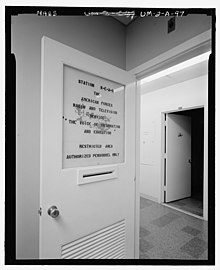 | |
| Broadcast area | Wake Island |
|---|---|
| Frequency | 1490 kHz [1] |
| Programming | |
| Format | Free-form |
| Ownership | |
| Owner | Armed Forces Radio and Television Services |
| History | |
First air date | before February 1969 [1] |
| Technical information | |
Licensing authority | FCC |
| Power | 500 watts |
Transmitter coordinates | 19°17′N 166°39′E / 19.283°N 166.650°E |
| Links | |
Public license information | |
KEAD was the callsign for two defunct American Forces Radio and Television Service radio stations on Wake Island, an unorganized, unincorporated territory of the United States. [2] On 1490 kHz AM, the station carried a mix of free-form live programming hosted by military personnel and other workers stationed on the island, while on KEAD-FM 104.5 MHz, the station played pre-recorded easy-listening music off reel-to-reel tapes. [3] The KEAD callsign was previously assigned to the Civil Aeronautics Authority navigation service station based on the island. [4]
In 2011, some 9,000 vintage vinyl records provided by AFRTS to the station from the mid-1960s into the 1970s were discovered in the old studio in a restricted area of the Wake Island Airfield terminal building. [2] [5]
References
- ^
a
b
"Broadcast Band News". Electronics Australia. Vol. 30, no. 11. Sydney, New South Wales, Australia. February 1969. p. 150.
A new radio station is reported to be operating on Wake Island in the Central Pacific. The station, using the call sign KEAD, is on 1490KHz, with programs in English 24 hours a day.
- ^ a b Hansen, Amy (December 5, 2011). "Treasure found on Wake Island: Thousands of original vinyl records stored at old AFRTS site". Inside PACAF. U.S. Air Force. Archived from the original on June 4, 2012. Retrieved January 31, 2012.
- ^ Blount, Clinton, ed. (March 14–15, 2001). "A Conversation with Dennis Lowden — Wake Island 1973–1975: U.S. Weather Service and the Evacuation from Viet Nam" (PDF). Independence, Missouri: Blue River Community College. Retrieved August 24, 2021.
- ^ Radio Navigational Aids. Washington, D.C.: United States Hydrographic Office. 1961. pp. 4–5.
- ^ McGrath, Timothy (January 2, 2008). "A View of Radio Station Door With Call Letters K-E-A-D Looking Southwest". AncientFaces.com. Retrieved January 31, 2012.
 | |
| Broadcast area | Wake Island |
|---|---|
| Frequency | 1490 kHz [1] |
| Programming | |
| Format | Free-form |
| Ownership | |
| Owner | Armed Forces Radio and Television Services |
| History | |
First air date | before February 1969 [1] |
| Technical information | |
Licensing authority | FCC |
| Power | 500 watts |
Transmitter coordinates | 19°17′N 166°39′E / 19.283°N 166.650°E |
| Links | |
Public license information | |
KEAD was the callsign for two defunct American Forces Radio and Television Service radio stations on Wake Island, an unorganized, unincorporated territory of the United States. [2] On 1490 kHz AM, the station carried a mix of free-form live programming hosted by military personnel and other workers stationed on the island, while on KEAD-FM 104.5 MHz, the station played pre-recorded easy-listening music off reel-to-reel tapes. [3] The KEAD callsign was previously assigned to the Civil Aeronautics Authority navigation service station based on the island. [4]
In 2011, some 9,000 vintage vinyl records provided by AFRTS to the station from the mid-1960s into the 1970s were discovered in the old studio in a restricted area of the Wake Island Airfield terminal building. [2] [5]
References
- ^
a
b
"Broadcast Band News". Electronics Australia. Vol. 30, no. 11. Sydney, New South Wales, Australia. February 1969. p. 150.
A new radio station is reported to be operating on Wake Island in the Central Pacific. The station, using the call sign KEAD, is on 1490KHz, with programs in English 24 hours a day.
- ^ a b Hansen, Amy (December 5, 2011). "Treasure found on Wake Island: Thousands of original vinyl records stored at old AFRTS site". Inside PACAF. U.S. Air Force. Archived from the original on June 4, 2012. Retrieved January 31, 2012.
- ^ Blount, Clinton, ed. (March 14–15, 2001). "A Conversation with Dennis Lowden — Wake Island 1973–1975: U.S. Weather Service and the Evacuation from Viet Nam" (PDF). Independence, Missouri: Blue River Community College. Retrieved August 24, 2021.
- ^ Radio Navigational Aids. Washington, D.C.: United States Hydrographic Office. 1961. pp. 4–5.
- ^ McGrath, Timothy (January 2, 2008). "A View of Radio Station Door With Call Letters K-E-A-D Looking Southwest". AncientFaces.com. Retrieved January 31, 2012.
